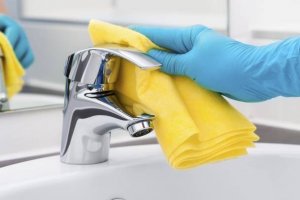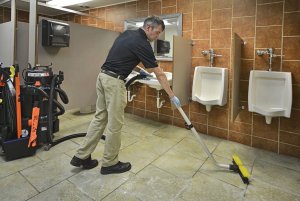According to the CDC, flu season begins to increase in October, flu activity peaks between December and February, and can continue as late as May, underscoring the importance for every type of commercial business throughout the Greater Pittsburgh area to employ regular deep cleanings of their restrooms to stave off the spread of flu, colds and other viruses and bacteria.
The following article explores the various diseases that often lurk within washrooms and an overview how our intense, regular deep cleaning Sani-Scub services can help further ensure the health of your employees and customers!
The Horrors One Can Find In A Company Restroom
When one has to go, one has to go and when it happens on company time, it can be a problem for many office workers. Company employees and customers have the right to expect restrooms to be clean, and responsible executives overseeing custodial operations must not disappoint.
The company restroom can be a setting for its own kind of urban horror tale, resting on the premise that what you can’t see can really hurt you.

It does seem like an ABC primer of common sense facts that commercial and building managers and owners should be aware of the connection between customer satisfaction and clean restrooms. And yet, surveys and studies reveal that only 80 percent of facilities managers are cognizant of this important association.
One fact that may explain this is that perhaps they themselves do not use the restrooms in their own facilities. Be that as it may, research further indicates that general restroom cleanliness in public restrooms are still greatly lacking.
For many users, the few minutes they are forced to confine themselves behind the locked doors of a commode can lead to strange behavior such as: pushing open the stall door via elbows, crouching dangerously above the seat so that it cannot come into contact with human skin and flushing with a shoe.
While germ paranoia may be a bit exaggerated, there is no question that there are many bugs lying in wait in the average company or public bathroom.
A Few Facts About Bathroom Germs
The germs that are present in human feces can wreak havoc when a toilet is flushed. They are propelled into the air with each flushing action.
According to Philip Tierno, MD, director of clinical microbiology and diagnostic immunology at New York University and Mt. Sinai Medical Centers, the best way to avoid becoming a landing site for this germ-infused, air-born mist is to vacate the stall immediately after flushing (do not pass go; do not collect $200 dollars.)
He states: “The greatest dispersal occurs not during the initial moments after the flush, but rather once most of the water has already left the bowl.”
Dispelling A Myth About Toilet Seats
It should be said that even though public bathrooms in Pittsburgh as well as other locations can and often do host a huge variety of pathogens that can cause illness, it is highly uncommon (if even possible) that the toilet seat can transfer STDs like Chlamydia or Gonorrhea to humans.
Most organisms cannot survive for long periods on the surface of the seat and transmission from the seat to a genital tract or through an open cut or sore on buttocks or thighs lies within the realm of possibility, but is very unlikely to occur.
In the words of Abigail Salyers, PhD and president of the American Society for Microbiology (ASM): “To my knowledge, no one has ever acquired an STD on the toilet seat unless they were having sex on the seat!” Judy Daly, PhD professor of pathology at the University of Utah in Salt Lake City states: “Even if you come into contact with particular viruses or bacteria, you would have to contract them in amounts large enough to make you sick.”
One of the reasons this myth has persisted is because it provides an easy way out of an uncomfortable confrontation. How a partner contracted an STD can be explained away with: “I have no idea, dear. I must have gotten it from a toilet seat.”
The Importance Of Bathroom Hygiene
Bathrooms and toilets are the most common breeding grounds for pathogens due to the humid temperatures that are always present. Germs love to breed in humidity and just one poorly maintained Pittsburgh public restroom can make many people very sick.
Pathogens create a domino effect, as once germs transfer to a human who becomes ill, that same person is likely to contaminate others within their orbit. The probability of transfer increases exponentially with public restrooms that are used by large numbers of people.
While there is no way to totally eliminate germs, the folks at Enviro-Master are experts at utilizing the best methods and equipment available anywhere for keeping them under control and maintaining a safe and hygienic odor-free company restroom.
Aside from regular and through cleanings, this includes: the introduction of hands free devices; automatic flush toilets; seat covers; hands-free soap; hand-sanitizer dispensers and sanitary floor mats, just to name a few.
A Few Relevant Studies and Statistics
Exploring microbial diversity within a restroom setting is particularly challenging for researchers due to the activities that occur and the high frequency of use by individuals with diverse hygienic routines. These features are likely to have strong influences on the types of bacteria observed on restroom surfaces.
One 1991 British survey involving 528 women at a clinic concluded that 85% said that they crouched over public toilets while urinating, and 12% papered the seat. Only 2% sat all the way down.
Some studies conducted in hospital bathrooms have indicated the presence of dangerous bacterial strains on toilet seats including antibiotic-resistant staphylococcus, (one of several “flesh-eating bacteria, norovirus (the cruise ship bug), E-coli, Samonella, Shigella and Streptococcus. It is possible that even the dreaded Ebola virus could be picked up from germs lurking in a public restroom.
More recent studies at the University of Arizona in Tucson discovered that sinks contain the greatest number of germ colonies in restrooms. This is due in part to the residue of water that is almost always present in any sink, which becomes a breeding ground for microscopic organisms.
At San Diego State University, researchers studying restrooms discovered that within one hour of cleaning and disinfecting, bathrooms were completely re-contaminated with microbes and fecal bacteria. The irony of the sink is inescapable. The very place one goes to wash their hands may well be the cause of the infection.
The Six Major Diseases To Fear From Public Restrooms
Viral infection carriers are never visible to the naked eye (or touchable by other body parts too impolite to mention).
According to William Dampier Assistant Professor, Microbiology and Immunology at Drexel University, healthy people are generally unlikely to contract a disease from a toilet seat unless there is an open wound or break in the skin that will permit ingress for the germs to penetrate the bloodstream.
A study published in Applied and Environmental Microbiology assessed the many microbes present in public restrooms. Scientists discovered genetic traces of more than 77,000 distinct types of bacteria and viruses in these public spaces.
This staggering list can be present in a single facility’s company bathroom. However, the most prevalent are: streptococcus, E-Coli, Methicillin-resistant Staphylococcus Aureus (MRSA), Salmonella, Shigella and Norovirus. These bacterial types have been known to cause serious and sometimes fatal diseases.
1) Salmonella
Salmonella infection is a bacterial disease that strikes the intestinal tract. The bacteria usually thrive in both human and animal intestines and they are released through fecal matter. Contaminated water or food, such as raw meat, poultry and seafood, is the most common way humans become infected and the chances of coming in contact with this infection are greater for those who travel to countries with poor sanitation.

This bacterial infection can be prevented from spreading by closing the lid after flushing. Washing hands thoroughly after using the toilet can also help prevent the transfer of the salmonella bacteria to the mouth or to any food preparation.
There have been several outbreaks of Salmonella in at least four food stores in Pittsburgh and western PA. This past June, Caito Foods, LLC recalled fresh cut watermelon, honeydew melon, cantaloupe, and fresh-cut fruit medley products containing contaminated melon.
According to the CDC, this past July, eight people were sickened with Salmonella after ingesting Honey Snacks.These incidents reflect the need for close surveillance of foodstuffs and the ongoing need to contact the experts at Enviro-Master for help in maintaining optimum sanitation of all vulnerable facility areas.
2) E-Coli
Escherichia coli is a rod-shaped, gram-positive bacterium that thrives in the intestines of healthy people and animals. While most strains of E-Coli are harmless, there are a few that can cause severe abdominal cramps, bloody diarrhea and vomiting.
The most common way to acquire an E-Coli infection is through the ingestion of food or water contaminated by human or animal feces. The waste pollutes the ground and the water from streams, rivers and lakes that are used to irrigate crops.
In the 2010 University of Arizona study entitled: Enteric Bacterial Contamination of Public Restroomsthat was referred to earlier, three researchers from University of Arizona focused on the determination of the occurrence of microbial “hotspots” in public facilities.
ResearchersDenise I. Kennedy, Carlos E. Enriquez and Charles P. Gerba, concluded that sinks, floors, toilet seats and sanitary napkin disposals were the most contaminated sites based on occurrence.
E-Coli was most commonly isolated at the sanitary napkin disposal drain in the sink basin and inside the urinals. All surfaces, in fact, revealed the presence of E-Coli except for the urinal top and the flush handle.
In April of 2018, a few supermarkets unknowingly carried an infected crop of romaine lettuce. This caused at least a dozen people in Western PA (Altoona) including one teenager, to be sickened by an E-Coli outbreak.
3) Staphylcoccus Aureus
While this might seem a moniker more fitting a little known Roman emperor, it is actually a bacterium that has long been considered one of the most important in terms of the disease it can cause human beings.
It is the leading cause of skin and soft tissue infections, and although staph infections are not usually serious, some are deadly, such as methicillin-resistant Staphylococcus aureusalso known as MRSA.
These antibiotic-resistant bacteria cause infection via a process known as fomite transmission, which means that it spreads to humans through bacteria that remain on bathroom surfaces, such as toilet seats, rather than transfer from person to person or from contaminated food or water.
The shared use of facilities in hospitals for example, can be a prime source of this bacterium and modern health care facility managers are highly vigilant and take many precautions to prevent it from spreading to their patients, who are already in a vulnerable state of health.
One important step includes consulting the bathroom sanitation experts at Enviro-Master for advice and help on how to tackle this dangerous adversary.
MRSA can thrive on a toilet seat and any other non-porous part of a toilet for more than two months, and it only takes a few seconds for it to transfer from a seat to human skin.
While this news by itself is rather scary, it should be put into perspective because the truth is that almost anyone is more likely to contract staphylococcus via use of a cell phone. According to a 2006 study, more than half of all cell phones tested were found to carry this bacterium.
4) Streptococcus
According to Dawn Shoemaker, a writer for the professional cleaning and buildingindustry,about 39% of all toilets harbor this nasty bacterium. There are many types of this common pathogen that is usually found in the throat.
Some of these strains serve to keep humans healthy, while others can be the cause of contagious infections, such as strep throat, meningitis and bronchial pneumonia. It can also cause necrotizing fasciitis, a crippling skin infection that is also known as “flesh-eating bacteria.”
In 2002, researchers from the Children’s Hospital of Pittsburgh discovered a highly antibiotic-resistant bacterium while conducting a study on the prevalence and nature of sore throats in children from kindergarten to eighth grade at a school in Pittsburgh.
5) Shigella
This group of bacteria is the cause of some 500,000 cases of a diarrheal disease known as Shigellosiswithin the United States. In the Pittsburgh area, there has been an increase in the incidence of this disease, and more than 90 cases have been reported since 2014. In July of 2018, there were 334 instances of this disease reported in San Diego County. This bacteria spreads through fecal contamination and symptoms include: diarrhea, fever and abdominal pain.
According to the U.S. Centers for Disease Control and Prevention, Shigella samples collected from communities across the nation continue to show signs of antibiotic resistance. Proper hand washing is the most effective means to prevent the spread of infection throughout a Pittsburgh commercial enterprise, but outside help from the hygiene experts at Enviro-Master can aid in the ongoing maintenance of a healthy public bathroom environment.
6) Norovirus
Norovirus causes 20 million illnesses every year in the United Sates causing 70,000 hospitalizations and 800 deaths.Also known as the “cruise ship virus,” this bacterium spreads very easily and quickly from one infected person to another and via contaminated food and other surfaces. Healthcare facilities are the most commonly affected settings in the United States, and over half of all reported outbreaks occur in long-term care facilities.
In addition, many outbreaks of food-related illness are caused by norovirus that is present in food service settings like restaurants. Outbreaks also frequently occur on cruise ships, in schools, child-care centers, colleges, and universities. Close quarters and shared spaces and surfaces make it easy for norovirus to spread.
A few years ago, the University of Pittsburgh in Johnstown, PA cancelled all of its indoor campus activities for a weekend due to an outbreak of norovirus that was rapidly spreading throughout the student body. The university collaborated with the Pennsylvania Department of Health and suspended cafeteria services at all of the campus dining facilities. They also brought in extended crews to clean and sanitize the campus.
Why Engage Enviro-Master For Your Pittsburgh Business Hygiene?
The six illnesses indicated above highlight the need for proper bathroom hygiene and professional maintenance, leadership and guidance provided by Enviro-Master Pittsburgh. This company is dedicated to providing superior restroom cleaning services and products that are 100% green.
Common diseases and viruses are no match for their weekly Sani-Service, which entails a visit by a highlytrained technician who sanitizes and coats restroom surfaces with a stain-resistant barrier known as Sani-Shield.

Enviro-Master’s Sani-Shield protects porcelain surfaces, which act like sponges and contain microscopic pores which in turn trap pathogens; glass ceramics, restroom fixtures, which harbor literally billions of bacteria; marble and other surfaces from the buildup of hard water minerals, rust and soap scum. This process makes cleaning much easier. In addition, Enviro-master’s Sani-Service includes free urinal screens, soap and air-freshener scent.
Owned and operated by highly experienced Pestco Group president, Arnold Zlotnik, this multi-generational business has been serving Pittsburgh and its environs for more than forty years.
In his own words: “… Enviro-Master brings outstanding products with service innovations and a reputation for excellence that our customers will appreciate. We are now able to meet a greater range of needs within our customer base and we can branch out within our community and the tri-state area with a full complement of hygiene services solutions.”

In conclusion, invest in your company bathroom by keeping it equipped with hands-free technologies and superior cleaning products. Perform regular checks and protect your brand and your business for the sake of that all- important bottom line. Enlist the aid of the experts at Enviro-Master. They are there to help and represent the best there is in terms of bathroom hygiene and cleaning solutions.
Final thoughts on what public bathrooms should not be: Welcome to the closet of olfactory sorrow and great fanny anguish. ~ Anonymous

